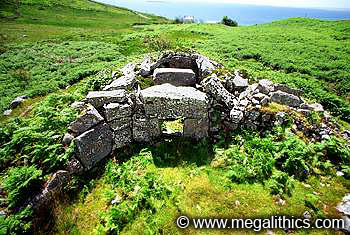
 |
|
More Pics |
|
|
Panoramas |
|
| G 64621 75167 (GPS 27min. entrance). | |
| Visited June 2002 |
The Croaghbeg Court Tomb, also known as Pontabane Carn, stands in a valley about 6km west of Killybegs, the remains of two other Court Tombs lie close by in the same valley. Croaghbeg is a full-court tomb and the axis is aligned almost N-S, the court and gallery are at the northern end looking up to the head of the valley. The tomb was excavated over the period 1969-73, this revealed a long cairn with a lintelled entrance to a two chambered gallery, with a subsidiary chamber on the NW side of the court.
The cairn is composed of the usual football-sized stones retained by dry-wall revetment and is 14m across at its widest point, it is currently about 37m long but the original length is unclear.
Determination of the court area was made difficult by its use as a potato garden in recent times, but this was a full court tomb and indications of a southern entrance were found. The cultivation of the court has resulted in the complete destruction of the western court wall including the facade adjoining the gallery entrance, the wall there today is simple cairn fill. The presence of the subsidiary chamber is a great aid in determining the limits of the the original court, if this chamber was positioned as at other Donegal Court Tombs, then the court here was probably about 10m long and at least 8m wide. The eastern side of the court is in a better state of preservation and ten stones stand here, a complete run up to the gallery entrance. Built on a stony ridge, the court stones stand directly on a stone infill used to level this important area.
The gallery entrance is about 80cm wide and is flanked by two massive jamb stones, a sill stone sits between them at ground level. The massive lintel stone is 2.2m wide and 0.9m thick and rests directly on the two jamb stones. The lintel seems to have been squared off on its front face, sides, top and bottom but the rear face of the stone is rough and uneven. The gallery itself is 5.5m long and is divided into two chambers by a set of segmenting jambs, these are about 65cm apart and also have a sill stone at their bases. A second lintel stone rests on the segmenting jambs, this stone is about 2.1m long and 0.8m thick, it appears to have been finished on all of its surfaces. The front chamber is about 2.6m long and 2.7m wide, the rear chamber is 2.7m long and varies in width from 2.3m to 3m. The sidewalls of the gallery are composed of three side slabs between 1.2m to 2m tall on each side. The middle side slabs are centred on the segmenting jambs, an arrangement also seen in the gallery of the nearby Shalwy Court Tomb. The back-stone of the chamber is a composite, having a lower element 1.3m high closely jointed with the 0.75m tall upper stone. The sides and rear of the gallery are all overhung by corbel stones which are still in situ. The corbels are heavy stones and in some places two courses still survive, in addition, there are several large stones lying on the surface of the cairn material which are probably displaced corbels.
The subsidiary chamber stands NW of the gallery and probably opened directly into the court, it is likely that it stands very close to what was the western side of the court entrance. The chamber is 1.8m long and 1.6m wide, the sides and rear are each composed of single large slabs which are up to 1.75m tall, the entrance is formed by two tall jamb stones which stand 40cm apart with a sill stone between. On excavation it was found that the floor of this chamber had been partly covered with neat stone paving.
Finds from the site were poor, only nine flint tools were found and some of these were in a poor state.
Although tricky to get to, Croaghbeg is an excellent site to visit, the gallery in particular is in a really good state of preservation and although open to the sky gives a real feel of the nature of the internal spaces in these tombs. As an added bonus the remains of two other Court Tomb stand close by in the same valley, those of Shalwy almost as well preserved as Croaghbeg, and the sad remnants of the almost disappeared Bavan.